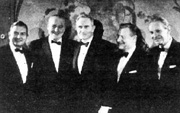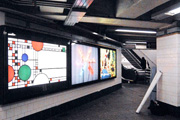On november 7, 1929, while the consequences of the Wall Street Crash were rocking the world of finance, the Rockefeller family savored one of their more lasting triumphs.
Abby Aldrich Rockefeller, the millionaire's wife, had succeeded after a year's work in creating a museum to which she could donate pieces from her exceptional modern art collection (which included works by Picasso, Matisse, Degas and Cézanne). And she had done it alone.

Mr Rockefeller could not stand modern art and refused to support this endeavor beyond the allowance he used to give her. So Abby, who had already attracted the attention of art enthusiasts by opening the 7th floor of their 9-floor family home to the public so they could see her collection (in a suite of especially-designed Art Deco rooms), sought money from private companies and investors.
And after approximately a year of hard work, that Thursday in 1929, history was made. The Museum of Modern Art was opening.
Picturing the importance of the Museum of Modern Art is simple. Just imagine 150,000 masterpieces from the last century co-existing with about 22,000 films (and 4 million film stills) in the same building in the heart of the world's most important city.
The problem is, said picture would not do the project justice -- the MoMA has what is considered the most important collection of modern art in the world, raging from paintings to sculpture, design to even typefaces.
It has the best-known masterpieces by the biggest names in modern art from all over the world.
Take the museum's paintings collection for instance: Vincent van Gogh (the museum is the proud owner of what is perhaps his most popular masterpiece, Starry Night) and Piet Mondrian (of Sea and Starry Sky Fame) from Holland; Salvador Dalí (and his iconic The Persistence of Memory) and Pablo Picasso (The Ladies of l'Avignon); Jackson Pollock (The Flame can be considered the most popular from the series owned by the museum), an dAndy Warhol (those mythic Campbell Soup iterations) from the US, and, finally, Claude Money (The Japanese Footbridge is a particular highlight) and Henri Mattise (of whom Abby Aldrich was a big fan -- you will see why when you check out the impossibly sensual La Japonaise.
It wouldn't be completely hyperbolic to say that you can claim to know modern art just by visiting the museum's collection for a reasonable time.

You can also claim to have some film and photography notions. since you can find an impressive array of stored films (There's the obvious, Film School student favorites like Vertigo or Citizen Kane, but there's also other less predictable ones like Andy Warhol's Empire, a cinema verité exercise in which the Empire State Building is filmed by a still camera for eight hours). In total, the department of Film and Video has hoarded about 14,000 films.
So obviously, they put their movie screening rooms to use with films from any time and anywhere in the world of different genres. It is always useful to know which cycle each screening pertains to, as their enrich the experience. And most times, they are tied with the exhibits, which is an experience you can only get in New York. Screenings held in the Gramercy Theater on 127 East 23rd Street.
It's not unusual for the Museum to screen current mainstream movies (usually in advance screenings) selected by the Museum's curators. Since the screenings are reserved for MoMA membership), they include added bonuses like bringing the movie's director, producer or screenwriter to discuss their work with the attendees.
The MoMA also supports up-and-coming local filmmakers its support by lending their brand to the prestigious New York Film Festival.